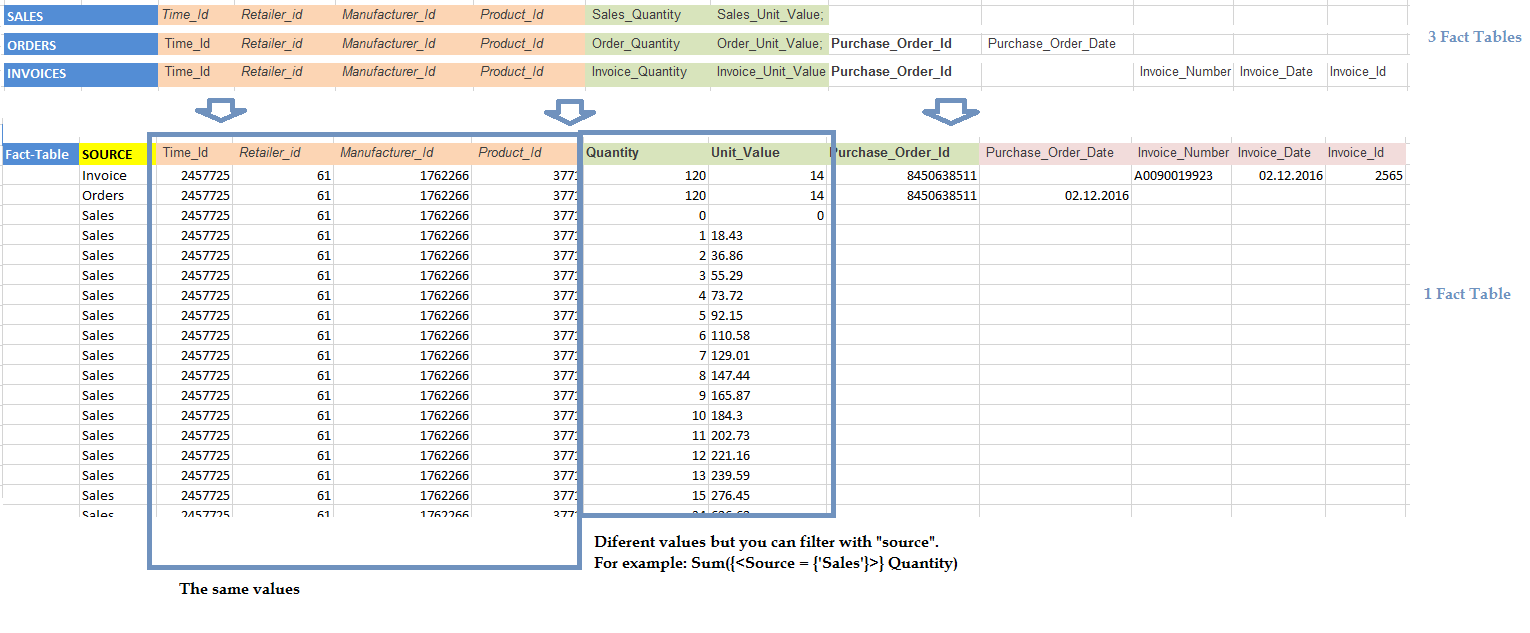Unlock a world of possibilities! Login now and discover the exclusive benefits awaiting you.
- Qlik Community
- :
- All Forums
- :
- QlikView App Dev
- :
- Re: Fact Table Dependency
- Subscribe to RSS Feed
- Mark Topic as New
- Mark Topic as Read
- Float this Topic for Current User
- Bookmark
- Subscribe
- Mute
- Printer Friendly Page
- Mark as New
- Bookmark
- Subscribe
- Mute
- Subscribe to RSS Feed
- Permalink
- Report Inappropriate Content
Fact Table Dependency
Hi everybody..
I've been working on a data model with 3 fact tables: Sales, Invoices and Purchase Orders. My model is connecting the 3 fact tables with a LinkTable using their common fields (Time_Id, Manufacturer_Id, Retailer_Id, Product_Id). So far so good, but there is a dependency between Invoices Fact Table and Purcharse Orders Fact Table because an invoice is related with a purchase order and one purchase order can have none, one or many invoices. I dont know how to model this without creating some "Frankestein" (Synthetic Key, Circular Reference, etc). Any ideas?
More or less my fact tables are described like this:
INVOICES:
Invoice_Id
, Time_Id
, Retailer_id
, Manufacturer_Id
, Product_Id
, Purchase_Order_Id
, Invoice_Number
, Invoice_Date
, Invoice_Quantity
, Invoice_Unit_Value;
PURCHASE_ORDERS:
Purchase_Order_Id
, Time_Id
, Retailer_id
, Manufacturer_Id
, Product_Id
, Purchase_Order_Number
, Purchase_Order_Date
, Order_Quantity
, Order_Unit_Value;
SALES:
Time_Id
, Retailer_id
, Manufacturer_Id
, Product_Id
, Sales_Quantity
, Sales_Unit_Value;
NOTE: Time, Retailer, Manufacturer, Product are my dimensions.
- « Previous Replies
-
- 1
- 2
- Next Replies »
- Mark as New
- Bookmark
- Subscribe
- Mute
- Subscribe to RSS Feed
- Permalink
- Report Inappropriate Content
Can you upload some dummy data in excel for all 3 fact tables that best respresents your scenario?
If a post helps to resolve your issue, please accept it as a Solution.
- Mark as New
- Bookmark
- Subscribe
- Mute
- Subscribe to RSS Feed
- Permalink
- Report Inappropriate Content
Hi
How can I attach the excel file?
- Mark as New
- Bookmark
- Subscribe
- Mute
- Subscribe to RSS Feed
- Permalink
- Report Inappropriate Content
Here's a how to
https://community.qlik.com/docs/DOC-16454
If a post helps to resolve your issue, please accept it as a Solution.
- Mark as New
- Bookmark
- Subscribe
- Mute
- Subscribe to RSS Feed
- Permalink
- Report Inappropriate Content
HI,If tables are depended on each other then do join them like and try to create single fact,
PURCHASE_ORDERS
Purchase_Order_Id,
Rest of fields
left join
Invoice Tabel
Purchase_Order_Id,
Rest of fields
- Mark as New
- Bookmark
- Subscribe
- Mute
- Subscribe to RSS Feed
- Permalink
- Report Inappropriate Content
Your best bet here is to concatenate the data into a single table with a 'source' derived key to differentiate:
Data:
LOAD
Invoice_Id
, Time_Id
, Retailer_id
, Manufacturer_Id
, Product_Id
, Purchase_Order_Id
, Invoice_Number
, Invoice_Date
, Invoice_Quantity
, Invoice_Unit_Value
, 'Invoices' as Source
FROM INVOICES;
Concatenate(Data)
LOAD
Purchase_Order_Id
, Time_Id
, Retailer_id
, Manufacturer_Id
, Product_Id
, Purchase_Order_Number
, Purchase_Order_Date
, Order_Quantity
, Order_Unit_Value
, 'Orders' as Source
FROM PURCHASE_ORDERS;
Concatenate(Data)
LOAD
Time_Id
, Retailer_id
, Manufacturer_Id
, Product_Id
, Sales_Quantity
, Sales_Unit_Value
, 'Sales' as Source
FROM SALES;
This makes analysis simpler and avoids a link table which can perform poorly if your data set it large. You can use simple set expressions to select which data is required - eg:
=Sum({<Source = {'Sales'}>} Sales_Quantity)
- Mark as New
- Bookmark
- Subscribe
- Mute
- Subscribe to RSS Feed
- Permalink
- Report Inappropriate Content
Hey Sir,
Wont that concatenation spoils the relation btn 2 table..
Bcs even with flag also they ll act as 2 separate entities ryt?
- Mark as New
- Bookmark
- Subscribe
- Mute
- Subscribe to RSS Feed
- Permalink
- Report Inappropriate Content
Hi
Finally I could send you the data.
Thanks in advance!
- Mark as New
- Bookmark
- Subscribe
- Mute
- Subscribe to RSS Feed
- Permalink
- Report Inappropriate Content
Thanks for your answer. But what if I want to analyse how many units where ordered (Purchase Order) and how many units were bought (Invoice) using the Purchase_Order_Number dimension? I'm getting value for units ordered but zero for units in invoices in spite of there are units related to an order number.
- Mark as New
- Bookmark
- Subscribe
- Mute
- Subscribe to RSS Feed
- Permalink
- Report Inappropriate Content
Hello Fernando,
have you found a solution for your Question?
I have in my Model that Problem too. I have 3 fact Tables und they are related.
What i did put in your Example is:

The Problem is that Invoice, Orders and sales are related and i don't know how to answer:
How many sales have generated orders ordered in April.
I mean, i don't know how can i relate the different "sources".
- « Previous Replies
-
- 1
- 2
- Next Replies »